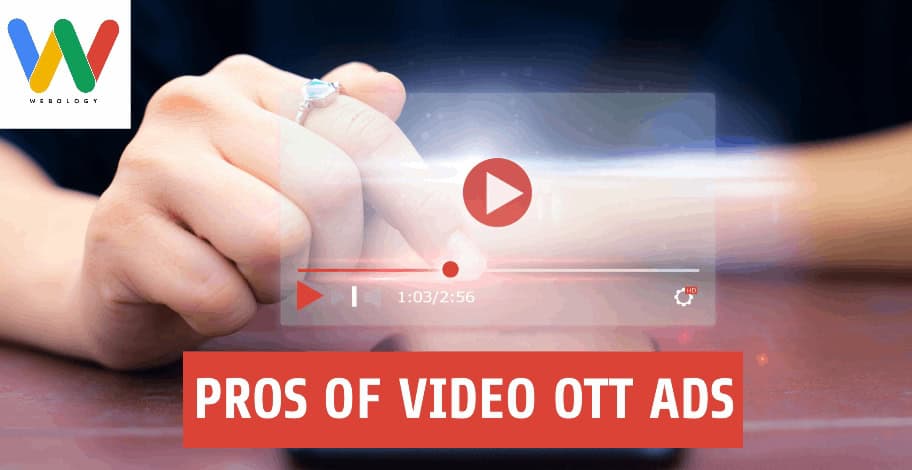Over-the-top (OTT) platforms aren’t just revolutionizing the way we consume content.
They’ve also opened doors for impactful advertising by providing diverse ad placement opportunities for businesses with just about any sort of budget.
Thanks to the wide adoption of streaming platforms, television advertising is more affordable than ever! If you’re considering OTT ads, knowing where these ads can make the most impact is important. You need to understand the viewership demographics and behavior in order to effectively target your audience.
Table of Contents
OTT platforms provide multiple touchpoints to engage your target audience. They’re perfect for driving prospects further down your sales funnel, promoting brand awareness and loyalty, as well as showcasing new products or services. With OTT, you can reach a highly engaged audience who are actively consuming content on their preferred devices.
 I’m Amy Gable, and outside of my role as VP of sales at Webology I have decades of experience in broadcast advertising. I watched the industry morph into the digital era and it’s such an exciting time to be in this space! In this blog post, we’ll learn:
I’m Amy Gable, and outside of my role as VP of sales at Webology I have decades of experience in broadcast advertising. I watched the industry morph into the digital era and it’s such an exciting time to be in this space! In this blog post, we’ll learn:
- What is OTT advertising?
- Where do Ads Come up in OTT Platforms?
- Benefits and drawbacks of using different OTT ads
Let’s dive in.
Where Do Ads Come Up In OTT Platforms?
First things first, ads on OTT platforms can show up in two main locations:
- Within the main content (Pre-roll, mid-roll, and post-roll video ads)
- Over the main content (Banner and overlay ads)
The exact location of your OTT ad will depend on the ad type you choose.
Before getting into different OTT ad types and their locations, it’s crucial to understand this advertising model.
What are OTT Ads?
OTT advertising refers to delivering ads on internet-enabled devices such as smart TVs, mobile phones, gaming consoles, etc.
If you’ve ever seen an ad while watching a video on platforms like Hulu and Netflix, you’re an OTT ad consumer! When I shared this little factoid with Blake by the way, he was like: 🤯
That’s part of the reason we’ve really started to push OTT ads when it makes sense for a client’s campaign. Unlike traditional TV ads, OTT advertising allows you to target very specific audiences based on individual viewing habits. And it works perfect when you mix it with our other services like SEO and landing page design to build out a comprehensive digital strategy.
Another reason OTT ads are amazing is that they also let you track user engagement and adjust your advertising strategy accordingly. You can serve up ads to people who engaged with at least 50% of your video for example, or retarget those who watched your ad but didn’t convert. This level of precision and data-driven decision making is what sets OTT advertising apart from other forms of digital marketing.
An OTT ad can be either a video or an image; its format influences where it is placed.
For instance, a banner ad appears at the top of the main content, whereas a video ad appears before, within, or after the main content (More on this later).
Importance of Ad Placement in OTT Advertising

In the fast-paced digital landscape, capturing the attention of your target audience is paramount to implementing an impactful OTT campaign.
Strategic ad placement ensures that your business is seen by the right people at the right time.
OTT advertising uses your audience’s viewing history to personalize ad placement, making it much more effective than traditional TV ads.
Proper ad placement helps you boost your click-through rate, brand recall, and conversion rates.
With OTT ads, you don’t have to waste your advertising budget on the wrong prospects, maximizing your ROI.
Where Are Ads Displayed on OTT Platforms?
Over-the-top advertising lets advertisers reach their target audience through various ad formats.
Each ad type has unique benefits and drawbacks, understanding which can help you decide the right fit for your advertising goals.
Let’s talk about where ads come up on OTT platforms in detail.
Video Ads
Video OTT ads bear a strong resemblance to traditional television commercials since they’re in the same format.
However, they can appear in three different locations, depending on when you want to showcase your brand. Based on that, video OTT ads are divided into three types:
Pre-Roll Ads
This type of OTT ad is probably the least intrusive. It appears right before someone starts consuming the main content and is designed to instantly capture your target audience’s attention and communicate your message quickly. This is why the usual length of a pre-roll ad is 15 – 30 seconds.
Mid-Roll Ads
The second type of video OTT ad, a mid-roll ad, appears somewhere within the main content. Since viewers are already engaged with the content, mid-roll ads can afford to be a bit longer, allowing advertisers to communicate their messages in detail.
Post-Roll Ads
These are short video ads that appear after the main content has finished running. With post-roll ads, you have the opportunity to leave a lasting impression on viewers, but they’re not that common because of potential viewer drop-off. A post-roll ad is normally anywhere between 15 and 30 seconds, but it can be longer.
Pros of Video OTT Ads

With video OTT ads, you have the option to create longer marketing messages, which can help your click-through rate.
In addition, video ads tend to be more engaging, helping advertisers to captivate their audience and build brand awareness. This is especially true on OTT platforms, where viewers are actively seeking out content and are more likely to be engaged with the ads they see.
Moreover, OTT ads allow for better targeting and personalization. Since these ads can be served directly through streaming devices or apps, advertisers have access to valuable data on viewers’ demographics, interests, and behaviors. This allows them to tailor their ad messages specifically to their target audience, leading to a higher conversion rate.
Cons of Video OTT Ads
Video ads can be super effective at driving engagement, but they can be more disruptive in nature.
Your viewers will either have to watch your ad or skip it manually. In either case, you’re disrupting their viewing experience.
Banner Ads
Banner ads usually appear at the top or bottom of the main content on an OTT platform.
Advertising materials typically used in a banner ad are logos, product images, and calls to action.
The nice thing is banner ads can be clickable, allowing you to direct users to your landing pages.
Pros of Banner Ads
The main advantage is that they’re less intrusive than other formats.
You can subtly introduce your brand at the top or bottom of viewers’ screens and drive the desired action.
Cons of Banner Ads
As online viewing experiences become more cluttered with marketing messages, viewers have developed banner blindness.
This can lead to your ad being ignored or overlooked by your target audience.
Overlay Ads
These types of video OTT ads appear on top of the main content, typically at the bottom.
Overlay ads are similar to digital pop-up ads, which makes them more noticeable.
This helps advertisers grab their target audience’s attention effectively.
Moreover, overlay ads can be clickable, allowing you to direct viewers to your external pages for conversion.
Pros of Overlay Ads
Overlay ads are clickable and more noticeable. They’re perfect for grabbing viewers’ attention and driving traffic to your landing page. Nothing works better than a well-crafted overlay ad that targets the right audience. Additionally, these ads are less intrusive compared to pre-roll and mid-roll ads, making them more user-friendly and less likely to be skipped by viewers.
Cons of Overlay Ads
The OTT ad format can be great at grabbing attention, but it can also be disruptive and negatively impact user experience. So, proceed with caution and make sure to test the placement and frequency of your overlay ads.
Where do Ads Come up in OTT Platforms: Amy’s Final Thoughts
As you can see, ads can come up on OTT platforms in different locations.
The exact location of an OTT ad mainly depends on the ad type.
Video OTT ads appear before, after, or in the middle of the main content. Whereas, banner and overlay ads are normally displayed at the top or bottom of the screen.
Here are some factors you should consider while selecting an OTT ad for your business:
- Advertising goal
- Budget
- Audience demographics and viewing history
- Content type
- Desired level of interactivity
Lastly, when selecting and creating an OTT ad, it’s important to strike a balance between visibility and user experience. While ads are a great way to generate revenue and reach potential customers, they should not disrupt the user’s viewing experience. Make sure your ad is relevant, non-intrusive, and adds value to the overall experience.
You May Also Like: How to Build a Website With SEO In Mind?









